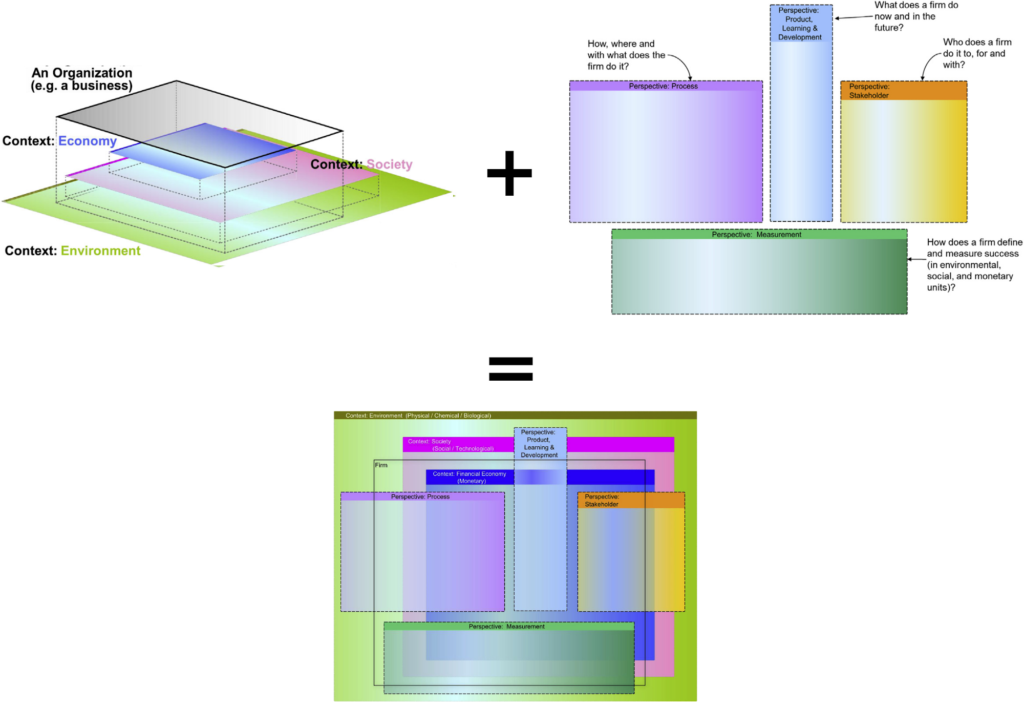Well designing its business model is important for any businesses. And this is particularly true for sustainable businesses. Because, in this case, at the very core of the business model should be present the will to reach sustainability. Otherwise, the company would be solely designed to seek for more monetary profit. So whatever your sustainable wishes are, seeking for monetary profit would be preponderant. And sometimes it may lead to contradictory decisions. Fortunately, there are suitable methodologies to build a sustainable business model at its core. The business model we will see is called: the strong sustainable business model. In this article I depict a methodology you can already use today to build a strong sustainable business model for your company.
But what is a business model and why is it so important?
Making your business model is one of the first thing to do when you want to start your company. A business model is a kind of modelisation depicting how your business is supposed to make value. The value your customer is ready to pay you. Taking time designing your business model will help you properly identify the fundamentals of your business such as: what do you want to solve and for whom, how you intend to create value for your customers, how you will reach your customers, how to be competitive, what are the costs and what will generate revenue. Putting all of this on paper helps going beyond the thrilling phase of the business creation to stay focused on concrete actions and decisions. This helps well finding out the fundamentals of your business before starting.
There are plenty of interesting tools to design a business model. One of the most famous is the Business Model CANVAS method.
What is a Business Model CANVAS?
A Business Model CANVAS is a tool to help you design and/or modify your business model is a convenient and clear manner. This helps easily break your business model into clearly distinguishable blocks. These blocks are named: the Key Resources block, the Key Activities block, the Key Partners block, the Value Propositions block, the Customer Relationships block, the Channels block, the Revenue Streams block, the Customer Segments block and the Cost Structure block.
Filling these blocks helps highlight and discover what aspects of your business model are required to generate value and make a profit. It can also help you improve your existing company in order to change your business strategy.
For each block you have to answer one or more questions about a specific aspect of your business. Below is a list of the questions you have to ask when filling your Business Model CANVAS’s blocks. Note that you can find an example of Business Model CANVAS application here.
What are the questions associated to each block?
- Value propositions: What is the value delivered to the customers?
- Customer segments: What are the most important customers?
- Channels: Through which channels the customers want to be reached? What are the best?
- Customer relationships: What type of relationship do we have with each customer segment? How to establish this relationship and how to maintain it?
- Key activities: What are the key activities required for our value propositions, our channels, our customer relationships and our revenue streams? Etc.
- Key resources: What are the key resources required for the value propositions, the channels, the customer relationships and the revenue streams? Etc.
- Key partners: What are the key partners of the company?
- Cost structure: What are the most important costs of the business?
- Revenue streams: What are the potential revenue sources of the business?
It is a great tool for business founders but it is based on a conventional definition of what is a good business model. This conventional definition may be a little bit flawed for a sustainable business. A conventional business model focuses on creating monetary profit solely. Therefore, in this case, it is sometimes harder or counter-intuitive to implement sustainable actions. Jones, Upward and James call this type of sustainable business: weak sustainable businesses. They mean that because they are only driven by monetary growth factors they cannot be completely sustainable by design. The authors proposed a new model to avoid this issue, the Strong Sustainable Business Model. They developed a CANVAS to help business creators to design a strong sustainable business model for their company.
Towards a strong sustainable model for your company
As said above, having a sustainable business is harder if the notion of sustainability is not taken into account by design. Jones, Upward and James think that this is not an easy task because conventional business models are monetary profit driven. So, taking into account the sustainability aspect may appear to be more a constraint than other thing for them.
The Strong Sustainable Business Model redefined the central notion of value generation. With this approach, there is a shift from a type of value generation which is exclusively measured by monetary profit to a type of value generation which is measured by three profits simultaneously. These three profits are: ecological profit, societal profit and monetary profit.
Ok but how to do that concretely?
Concretely, Jones, Upward and James proposed the Strong Sustainable Business Model CANVAS (or SSBMC).
With this new CANVAS, three boundary contexts are taken into account: the environment (physical, chemical and biological), the society (social, technological) and the financial economy.
A SSBMC is designed to combine all these three contexts as well as four perspectives.
The four perspectives are an adaptation of the Balanced Scorecard (Kaplan): the Stakeholder perspective (who the organization does it for, to and with), the Product, Learning and Development perspective (what the organization does now and in the future), the Process perspective (how, where and with what does the organization do it) and the Measurement perspective (how does the organization define and measure its success).

The intersections of the contexts and perspectives give us new other question blocks. There are 20 question blocks compared to only 9 for the conventional business model CANVAS. Filling these blocks will help you design a strong sustainable model for your company.

What are the questions associated to each block?
Here are the questions to answer to fill each block (questions extracted from this paper):
For the stakeholder perspective:
- Actor: Who are the human and non-human actors who may choose to engage with the business? Which actors are representing the needs of other humans, groups, and non-humans?
- Needs: Which human and non-human actors’ fundamental needs is the organization intending to satisfy? What needs do the actors have which the organization can meet or might prevent an actor from fulfilling?
- Stakeholders: What roles do all the actors involved with the organizations take?
- Relationships: What is the nature of the relationships with the organization’s stakeholders that must be cultivated and maintained?
- Channels: What channels will be used to communicate, developing the required relationships, with each stakeholder (and vice versa)? How will value propositions be delivered or co-created with each stakeholder?
For the Perspective, Product Learning and Development perspective:
- Value propositions: How is value co-created/co-destroyed between the organization and stakeholders and other actors? What are the positive (value creating) and negative (value destroying) value propositions for each stakeholder now and in the future? How does each value proposition relate to meeting each stakeholder actor’s needs or might prevent that actor from fulfilling a need?
For the process perspective:
- Organization: What are the business models of the organizations involved in the co-creation/co-destruction, delivery and maintenance of the value propositions? How do those organizations’ creation, delivery and maintenance of their (positive and negative) value proposition alter the definition and measurement of success?
- Decision: What is the governance of the organization? Which stakeholders get to make decisions about the organization’s definition of success and what the organization does to achieve that success? (e.g. what channels are used to develop and maintain which relationships with which actors taking which stakeholder roles, and, where and how are activities undertaken and resources transformed?).
- Partnerships: What formal stakeholder relationships are required to deliver the organization’s value propositions? Who are the organization’s partners and what agreements for resources and activities have been made with them?
- Resources: What tangible and intangible resources (human, social, knowledge, monetary, energy) are required to co-create, deliver and maintain the organization’s value propositions?
- Biophysical Stocks: Which bio-physical materials are moved and/or transformed during the processes that create, deliver and maintain the organization’s value propositions (considering the entire lifecycle of all technology and biological nutrients)?
- Activities: What activities are required to co-create, deliver and maintain the organization’s value propositions? What are the organizations business processes? Are these activities social, monetary, or bio-physical or a combination?
- Ecosystem Services: Which outputs from which ecosystem services are used in, harmed or improved by the activities that co-create, deliver and maintain the organization’s value propositions?
For the measurement perspective:
- Success: How does the organization define success environmentally, socially and economically (from the perspective of all stakeholders with the decision rights to define organization success)?
- Tri-profit: How does the organization choose to calculate profit e environmentally, socially, financially any point in time? How are the costs ‘subtracted’ from the revenues for each of environmental, social and monetary costs and revenues and ‘summed’ to calculate tri-profit?
- Valuation Method: How does the organization value contributions to success? How does the organization calculate measures of environmental, social or monetary costs, revenues or any and all assets from measures of process performance and/or the value customer and other stakeholders place on the value propositions? (e.g. typically customer stakeholders are willing to pay to receive a value proposition via a monetary pricing calculation).
- Processes (Measure): How does the organization measure those aspects of the organization’s processes that define success (e.g. quality, quantity, timeliness, satisfaction, etc.) in environmental (System International), social (happiness, well-being), and economic (monetary) units?
- Costs: How does the organization measure the costs incurred at any point in time? How are costs valued in financial terms (e.g. payments made to stakeholders, particularly suppliers), social terms (e.g. decreased happiness, illness etc.), environmental terms (e.g. nature harmed or depleted)?
- Revenues: How does the organization choose to measure the revenue generated at any point in time? How are revenues valued in financial terms (e.g. payments received from customers), social terms (e.g. increased happiness, wellbeing etc.), environmental terms (e.g. improved state of nature).
- Assets: How does the organization measure the value of the assets required, created or depleted over time? How are assets valued in financial terms (e.g. financial valuation), social terms (e.g. social capital, knowledge capital, brand value), environmental terms (e.g. natural capital restored or harmed).
To conclude:
Answering these questions help the business creators define a business model seeking tri-profitability (environmental, social and monetary). The goal is to reach a strongly sustainable business model by design.
The same authors propose now a less academic version of this CANVAS. This version is easier for everyone to fill and use. They named this new CANVAS: the Flourishing Business CANVAS. That’s an updated CANVAS you can use to build a strong sustainable model for your company.
On their website you can have access to interesting cases studies.
In the future, there will be other articles to cover other ways to build a business model which are sustainable by design.
I hope you enjoyed this article! As usual. I would be happy to read your suggestions in the comments to make this article more useful for you! And if you notice a dead link or an outdated information, please let me know!
Bye!


